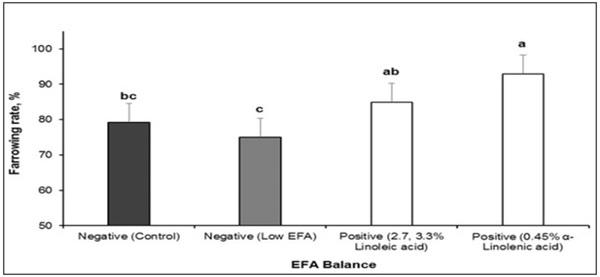Role of Essential Fatty Acids in Transition Sow Diet


Capper, J. L., Wilkinson, R. G., Mackenzie, A. M. and Sinclair, L.A. (2006). Polyunsaturated Fatty Acid Supplementation during Pregnancy Alters Neonatal Behaviour in Sheep. The Journal of Nutrition, Volume 136, Issue 2, Pages 397–403.
Decoux, M. (2017). Adjusting sow nutrition in key stages of transition. Pig Progress May 31, 2017. https://www.pigprogress.net/Sows/Partner/2017/5/Adjusting-sow-nutrition-in-key-stages-of-transition-125051E/
Eastwood, L., Leterme, P., and Beaulieu, A D. (2014). Changing the omega-6 to omega-3 fatty acid ratio in sow diets alters serum, colostrum, and milk fatty acid profiles, but has minimal impact on reproductive performance. J Anim Sci. 2014 Dec; 92(12):5567-82.
Gabler N.K., Spencer J.D., Webel D.M., Spurlock M.E. (2007). In utero and postnatal exposure to long chain (n-3) PUFA enhances intestinal glucose absorption and energy stores in weanling pigs. J Nutr. 2007; 137:2351–2358.
Hansen, A. V., Lauridsen, C., Sorensen, M. T., Knudsen, K. E. B. and Theil, P. K. (2012a). Effects of nutrient supply, plasma metabolites, and nutritional status of sows during transition on performance in the next lactation. J. Anim. Sci. 90: 466480.
Jin, C., Fang, Z., Lin, Y., Che, L., Wu, C., Xu, S., Feng, B., Wu, Li J. (2017).Influence of dietary fat source on sow and litter performance, colostrum and milk fatty acid profile in late gestation and lactation. Anim Sci J. 2017 Nov;88(11):1768-1778.
Nemeth, M., Wallner, B., Siutz. C., A., Pschernig. Wagner, K. H. C. and Millesi, E. (2017). A Steroid hormone concentrations and body mass are differently affected by polyunsaturated fatty acids during the oestrous cycle in guinea pigs. Reproduction, Fertility and Development 30(8) 1077-1086.
Nguyen, D. H., Yun, H. M. and Kim, I. H. (2020). Evaluating Impacts of Different Omega‐6 to Omega‐3 Fatty Acid Ratios in Corn–Soybean Meal‐Based Diet on Growth Performance, Nutrient Digestibility,Blood Profiles, Fecal Microbial, and Gas Emission in Growing Pigs. Animals, 10, 42.
Rooke, J.A., Sinclair, S.A. Edwards, R., Cordoba, S., Pkiyach, P.C., Penny, P., Penny, A.M., Finch, and G.W. Horgan. 2001. The effect of feeding salmon oil to sows throughout pregnancy on pre-weaning mortality of piglets. J. Anim. Sci. 73:489–500.
Rosero, D. S., Odle, J, Mendoza, S. M., Fellner, V. and van Heugten, E. (2016) Impact of dietary lipids on sow milk composition and balance of essential fatty acids during lactation in prolific sows. J Anim Sci. 2015 Jun; 93(6):2935-4.
Rosero, D. S., Boyd , R., Odle, J. and van Heugten, E. (2016) Optimizing dietary lipid use to improve essential fatty acid status and reproductive performance of the modern lactating sow: a review. Journal of Animal Science and Biotechnology (2016) 7:34.
Sampels, S., Pickova, J. and Högberg, A. (2010). Fatty Acid Transfer From Sow to Piglet Differs for Different Polyunsaturated Fatty Acids (PUFA). Physiol. Res. 60: 113-124, 2011.
Smits, R. J., Luxford B. G., Mitchell, M. and Nottle. M. B. (2001). Sow litter size is increased in the subsequent parity when lactat-ing sows are fed diets containing n-3 fatty acids from fish oil. J. Anim. Sci. 89:2731–2738
Staples, C. R., Burke, J M and Burke, W. W. (1998). Influence of Supplemental Fats on Reproductive Tissues and Performance of Lactating Cows. Journal of Dairy Science. March 1998 Volume 81, Issue 3, Pages 856–871.
Upadhaya, S. D., Yang, J., Lee, K. Y. and Kim I. H. (2018). Effects of changing omega-6 to omega-3 fatty acid ratios in corn–soybean meal-based diet on performance, serum lipid profile and colostrum and milk composition of sows and performance of piglets. Animal Production Science 59(7) 1235-1243.
Wilkinson, S. J., Downing, J. A., Thomson, P. C. and Newman, R. E. (2013). Dietary fatty acids affect the growth, body composition and performance of post-weaning gilt progeny. Animal Production Science 54(3) 329-338.







.jpg&w=3840&q=75)